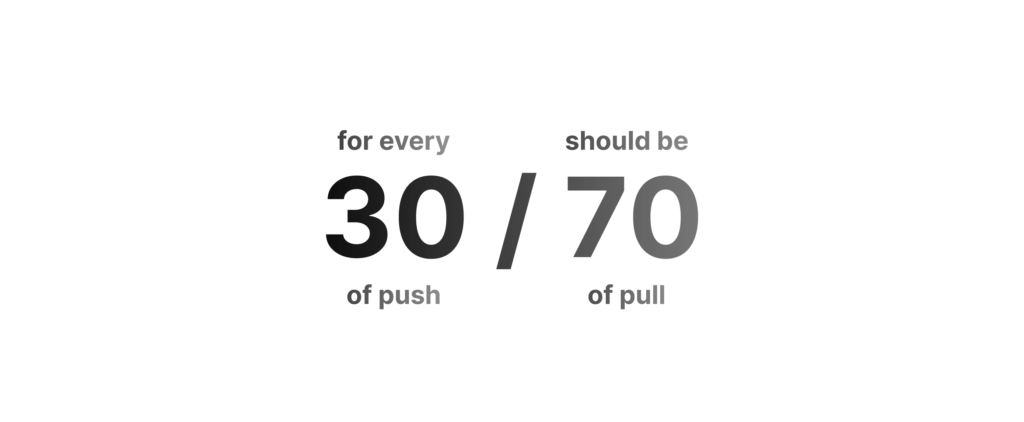The 30/70 rule is a versatile concept that can be applied to various aspects of life, such as lifestyle, relationships, speech, finance, and education. This mindset promotes balance, making it effective in product-led growth (PLG) businesses. The rule emphasizes balancing product development with sales and marketing efforts for sustainable growth.
The push and pull of growth in PLG businesses

PLG businesses have two growth drivers: push and pull. The pull refers to having an exceptional product that naturally attracts customers due to its quality, usefulness, or innovation. The push, on the other hand, encompasses the company’s sales and marketing strategies, which are designed to actively promote and sell the product. Sustainable growth relies on maintaining an equilibrium between these two forces.
Regarding growth, PQLs (Product-qualified Leads) are also important for sustainable and reliable revenue growth.
The seesaw analogy: 30/70 rule in PLG business to balance product development and sales/marketing efforts

The 30/70 rule resembles a well-balanced seesaw, where product development and sales/marketing efforts are the two sides.
The 70% side, or the sturdy foundation, represents developing the best possible product. This means continuously refining the product, incorporating user feedback, and keeping a close eye on market trends to ensure it stays ahead of the competition.
The 30% side of the seesaw represents the energy and momentum needed to propel the product into the market. Companies should allocate no less than 30% of their resources to sales and marketing activities. This can include advertising campaigns, public relations efforts, social media engagement, and other promotional strategies that help raise awareness and generate demand for the product.
Key consequences of implementing the 30/70 rule in PLG businesses
Adhering to the 30/70 rule in PLG businesses, much like maintaining balance on a seesaw, has two critical consequences:
Ensuring a high-quality product
Committing resources to product development helps companies improve their offering and remain competitive. This focus also builds customer trust and loyalty, as users expect reliable and valuable solutions.
Optimizing sales and marketing efforts
Consistent investment in sales and marketing raises product awareness and reaches a wider audience. This generates new customers and fuels company growth. A well-executed marketing strategy differentiates the product and creates a strong brand identity.
The 30/70 rule in real life: a SaaS project management tool
I witnessed how a SaaS project management company successfully implemented the 30/70 rule to achieve sustainable growth. They allocated 70% of their resources to product development, focusing on unique features like real-time collaboration, advanced task management, and powerful reporting tools. By actively seeking user feedback and monitoring market trends, they managed to create a product that met their audience’s needs.
On the other hand, they dedicated 30% of their resources to sales and marketing activities. They used targeted advertising campaigns, content marketing, and a free trial to raise awareness and attract new customers. This approach effectively showcased the benefits of using StreamDesk for project management.
As a result of applying the 30/70 rule, the company experienced significant growth in its user base and revenue. The high-quality, competitive product led to strong customer retention and word-of-mouth referrals, while the sales and marketing efforts successfully attracted new users. The company’s balanced approach made them a leading player in the project management software market.
Last words
In conclusion, the 30/70 rule offers a valuable framework for PLG businesses, balancing product development with sales and marketing efforts. By allocating resources according to this rule, companies can maintain a competitive product while raising awareness and generating demand. Like a perfectly balanced seesaw ride, this dual-focus approach drives sustainable, long-term growth and success.
The 30/70 rule FAQs
What is the 70-30 rule theory?
The 70-30 rule theory promotes balance in life and business. It focuses on dividing resources between two key components: 70% for one aspect and 30% for the other.
What is an example of 70-30 rule?
For example, in personal finance, the 70-30 rule suggests allocating 70% of income to essentials like rent, utilities, and groceries. The remaining 30% goes towards savings and discretionary spending, such as entertainment and hobbies. This rule helps maintain a balanced financial life, covering necessary expenses while enjoying personal interests and building savings.
What is the 70-30 rule in business?
The 70-30 rule in business guides resource allocation to balance two key components. In product-led growth businesses, it suggests investing 70% in product development for a competitive product and 30% in sales and marketing efforts to raise awareness and attract customers.





